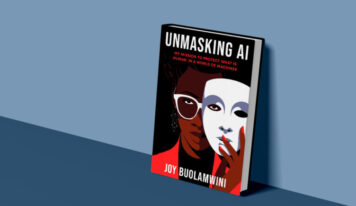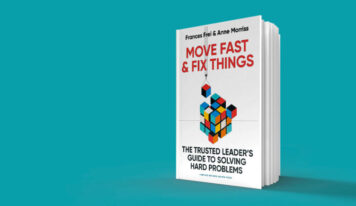Learn storytelling from Steve Jobs, Pope Francis, Churchill, and other leadership legends
Central Ideas:
1 – Just before he passed away, Steve Jobs showed his side as a great storyteller by introducing the product the iPad 2: “We’ve worked on this product for a long time, and I don’t want to lose that. It’s the marriage of technology and the humanities that makes our hearts glad.
2 -Mami Sato, a Japanese athlete, was chosen at the last minute to present Tokyo’s bid for the 2020 Olympic Games. She had lost her leg to cancer and excelled in the Paralympic Games. She told her personal trajectory. The emotion conquered the IOC.
3 – “If it can’t be explained on the back of an envelope, it’s garbage,” says dyslexic billionaire Richard Branson. In a short 13-word sentence, Branson identified one of the key components of an engaging corporate story: brevity.
4 – One of today’s great storytellers is Pope Francis who constantly uses the rule of three in allocutions, as in the example of a sermon in the Basilica of Santa Sabina in Rome: “Today’s Gospel indicates the elements of the spiritual journey of Lent: praying, fasting, and doing charity.
5. After failing in his initial speech as a member of parliament, Churchill honed his oratory skills and was successful on June 18, 1940: “I believe that the battle of Britain is about to begin. On it depends the survival of Christian civilization and the continuance of our institutions and our empire…”. The reaction to Hitler began.
About the author:
Carmine Gallo is author, among others, of the books TED – Speaking, Convincing, Emotional; How to Present to Large Audiences and Innovation – The Art of Steve Jobs. He is a communications advisor to brands such as Pfizer, Linkedin, Intel, and Coca-Cola.
Introduction
Twenty-five years later [a TV anchor in Wisconsin], I caught myself asking the same question again, “Why am I here?” In May 2014, I was invited to speak at the Khosla Ventures Summit, an exclusive gathering of entrepreneurs and CEOs held at a resort at the foot of the Golden Gate Bridge in Martin County. Vinod Khosla, venture capitalist and billionaire, had invited me personally, however, at first I could not understand why. Among the other speakers were Bill Gates, Sergey Brin and Larry Page, founders of Google, Marc Benioff, CEO of Salesforce, Condoleezza Rice, former US Secretary of State, and Tony Blair, former British Prime Minister.
Although more comfortable with Khosla’s encouragement, I was startled to look around the room and realize that every single person in attendance was already a storyteller. In fact, I had written about the most famous of them and their communication styles. However, the young entrepreneurs in the audience were also storytellers, some better than others, but all had had to learn how to tell a story because at some point they felt the hope to change the world with their ideas. In fact, those who stood out knew intuitively what neuroscientists and researchers are beginning to understand: an emotionally lived story is far more persuasive than mounds of data on 85 PowerPoint slides.
At the time of Khosla’s event, I kept thinking about the topic of my next book. I was on the lecture circuit promoting TED – Talk, Convince, Thrill, about the secrets of presentations by the world’s greatest thinkers and entrepreneurs. And it wasn’t just while I was promoting my book: I noticed the subject of storytelling coming up in a number of other contexts. When I interviewed the famous investor Ben Horowitz, he noted that among entrepreneurs, “storytelling is the most overlooked skill.
When you offer your product or service to a new customer, you are telling a story. When you instruct a team or educate a class, you are telling a story. When you prepare a PowerPoint presentation for your next sales meeting, you are telling a story. When you attend a job interview and the recruiter asks you about your previous experiences, you are telling a story. However, there is a difference between a story, a good story, and a transformative story that builds trust leverages sales and inspires people to have bigger dreams.
One of the great discoveries of this book is the fact that most great storytellers had difficulties in life and managed to turn them into victory. Their failures make them more interesting because, as you will see, we are naturally eager for stories of overcoming.
PART I: Storytellers who light our inner flame

Steve Jobs – What cheers your heart?
The punch in the gut. The “wow” moment. The “aha” moment. Regardless of what you choose to call it, radical transformations can happen in an instant. However, an idea will only catch on if the person who had it can convince others to act. Otherwise, ideas are just neurons firing in someone’s brain. The biggest waste is an unrealized idea that fails to connect with its audience, not because it is bad, but because it is not packaged in a way that makes people move.
In March 2011, the visionary who made “just one more thing” a personal catchphrase took the stage one last time to reveal Apple’s secret sauce. Steve Jobs, thin and weak from a cancer that would take his life a few months later, made an unexpected appearance to introduce a new product, the iPad 2. Few people in the audience expected him to appear, as he was on his third medical leave. “We’ve worked on this product for a long time, and I don’t want to miss it,” he told the excited audience. Jobs ended his presentation with the following remark:
“It is the marriage of technology and the humanities that gladdens our hearts.”
In one sentence, Steve Jobs captured the essence of what makes an inspiring storyteller. As Sculley also captured it when he said that Jobs was passionate about making a difference. Passion is everything, and Jobs had plenty of it.
Your story begins with your passion. You cannot inspire if you are not inspired. Passion, however, is a puzzle. Almost all people know it when they see it, but have difficulty discovering it for themselves. Steve Jobs discovered his passion by asking, “What gladdens my heart?” The answer to that question is somewhat different from the answer to “What do I do?” Steve Jobs made computers; building tools that helped people unleash their creativity was what delighted his heart.
On June 12th, 2005, Steve Jobs gave one of the greatest graduation speeches in history: 2,250 words in 15 minutes. Jobs, the storyteller, built a three-part narrative on a central theme: do what you love. The speech, super moving, had more than 20 million views on YouTube. Apple employees speak with conviction that Steve Jobs’ passion lives on in the company’s DNA.
Howard Schultz – The coffee king puts his heart into the company
Fred Schultz and his family had no income, no health insurance, no unemployment insurance, not even a place to drop dead. At a young age, living a hard life in a low-income Brooklyn home, Howard Schultz, Fred’s son, had the experience that would shape his values and aspirations: “I knew in my heart that if I was ever in a position to make a difference, I would not leave people behind.” Today, as CEO and president of Starbucks, Howard is in a position to make a difference for more than 180,000 employees and their families.
Schulz often tells his father’s story to exemplify Starbucks’ mission and values. His father’s story shapes the “why” of the organization’s initiatives. Schultz’s vision was to build a company that treated people with dignity and respect, the treatment his father never got. “Coffee is the product we sell, however, it is not our business,” he says. “We’re not in the coffee business. Well, we are as a product. But we are in the people business. It’s all human connection.”
Schultz tells the story of Italy often, always in consistent detail, and it has become part of Starbucks’ traditions. Here, he is in an interview for The Disruptors program on the Bloomberg Channel; note how similar it is to the story he told Oprah: “A year after I joined the company, I went to Italy for the first time. You can’t walk through any major city or town without walking into a coffee shop and seeing the sense of community, romance, and theater around espresso. This makes me understand that Starbucks was not in the right part of the coffee business. The real business and the real opportunity was to integrate the beverage with a sense of destination and community in the store.”
Schultz takes 30 seconds to tell the origin story, the story of the Starbucks brand. It was critical to the brand’s success because in 1987, few people in the United States had heard of the latte. They didn’t know what to do with the “third place” concept [between home and work]. Even the founders of Starbucks rejected Schultz’s idea at first. He left the company for two years and opened his own Italian coffee shop. The founders, in financial difficulty, called him back, and in 1987 sold him the company for $3.8 million.
Only then did Schultz really have the opportunity to realize his full life, creating an experience where people would come to the store to enjoy their coffee and talk, not just buy beans. The following year, when, according to Schultz, “employee generosity was completely out of fashion, Starbucks became one of the few companies to provide health insurance coverage for all employees, including part-time employees.” What guided and still guides Schultz is the stated goal, to treat employees well and in return be rewarded with good service and loyalty. Besides, it is the right thing to do.
PART II: Storytellers who educate
Tokyo 2020 – Japan unleashes its best storytellers to win Olympic gold
Mami Sato enjoyed her active lifestyle. Her days at Waseda University in central Tokyo were filled with classes, running, swimming, and cheerleading. One day, the 19-year-old began to feel pain in her right ankle. The pain turned out to be cancer; only a few weeks after the first symptom, she lost her leg to the disease.
Sato was not discouraged, trained hard, and earned a spot as a long jump athlete at the 2004 Paralympic Games in Athens. She competed in other Olympic rounds: in Beijing, 2008; in London, 2012.
Fate, however, required of her yet another ordeal. In March 2011, an earthquake triggered a gigantic tsunami, involving the Fukushima nuclear power plant. The destruction encompassed Sato’s hometown of Kesennuma, seven minutes from Fukushima. Sato and a group of 200 athletes brought encouragement and supplies to families affected by the tragedy.
Sato shared his story in September 2013, while on the rostrum leading Tokyo’s presentation for the 125th session of the International Olympic Committee (IOC) in Buenos Aires, Argentina. IOC members were watching the presentations to award one city the right to host the 2020 Olympic Games. The two other finalists, Istanbul and Madrid, were thought to be favorites.
The Prime Minister of Japan was expected to be the main presenter. However, at the last minute, two days before the event, the team responsible for the presentation concluded that the best strategy was to start the presentation with an emotional story, and there was no one better than Mami Sato as a story-athlete. Sato didn’t know much English, but the staff convinced her that the most important thing was her personal story.
“I was a runner. I was a swimmer. I was even a cheerleader,” she told the Olympic Committee about her life before cancer. Once she returned to college and started competing in sports, her attitude changed: “I found that I loved to set goals and beat them. I developed new confidence. More than anything, I learned that what was important was what I had, not what I had lost. And I felt privileged to have been touched by the power of sport.” When the IOC announced that Tokyo had won, hundreds of thousands of people took to the streets of Japanese cities to celebrate the achievement achieved by Sato’s storytelling.
According to The Guardian, “Tokyo’s previous bids were praised for competence but criticized for a lack of passion. The IOC judges recognized the Japanese team for their inclusion of emotion and passion in their proposal. Mami Sato’s story dictated the pace of the rest of the presentation. Having a storyteller like her is an asset, but only if she is allowed to tell her story.
Sir Ken Robinson – A funny look at the most popular TED talk of all time
Born in Liverpool in 1950, Ken Robinson was one of seven children. His father played semi-professional soccer and dreamed of the boy following in his footsteps, perhaps taking the family’s soccer legacy to another level. His hopes were dashed when his son got polio at age 4, which caused paralysis in one leg.
Undaunted, Robinson would seek success in the academic field. He dabbled in his studies and, in 1968, attended Bretton Hall College as an English and drama student. In 1981, he completed his doctorate at the University of London, with a specialization in theater in education. A list of credentials does not storytelling make, but in Robinson’s case, his focus on theater helps explain why his TED talk would go viral and be a sensation – in fact, the most popular TED talk of all time.
“The brain doesn’t pay attention to boring things,” writes John Medina, a molecular biologist at the University of Washington. Robinson is anything but boring. Within the first 50 seconds of his TED talk, the laughter was already being heard. Here is an excerpt from the first five minutes of his presentation.
“I heard a great story recently – I love to tell it – from a little girl who was in a drawing class. She was 6 years old and she would stand in the back of the room, drawing. The teacher said that she hardly paid attention to the class, except for this one, drawing. The teacher was fascinated. She went up to the girl and asked: “What are you drawing? And the girl answered: “I am drawing a picture of God. And the teacher said, “But nobody knows what God looks like. And the girl said, “They will know in a minute.” (Laughter)
Robinson wrote a book called The Element, about following your life’s true mission, where “natural aptitude meets personal passion.” He claims that there is a serious reason to find one’s element: “Many people have no purpose in life. The evidence of this is everywhere; in the large number of people who are not interested in the work they do; in the growing number of students who feel alienated by the educational system; and in the increasing use of antidepressants, alcohol, and painkillers everywhere.”
No one is going to listen to a story if they are not paying attention, and if they are not paying attention, they will not learn. Robinson’s serious subjects would have trouble finding a wide audience were it not for this humorous view of everyday situations.
PART III – Storytellers who make it simple

Richard Branson – If something can’t be explained on the back of an envelope, it’s junk
“I was a problem kid – and always in trouble,” Richard Branson recalls. “At 8 years old, I still couldn’t read… Dyslexia was not considered a problem back then, or, to be more accurate, it was a problem only if you were dyslexic. Since nobody had ever heard of dyslexia, being unable to read, write or pronounce meant, to the teachers and the rest of the class, that you were stupid or lazy. And in elementary school, you would get beat for both.”
“The reason I think dyslexics seem to do so well in life, even though they have a hell of a school term, is that they have to simplify things,” Richard told CNN’s, Anderson Cooper.
“If something can’t be explained on the back of an envelope, it’s garbage.” In a short, 13-word sentence, Branson identified one of the key components of an engaging corporate story: brevity. His advice reminds me of a tip I heard from one of Google’s early investors, at Sequoia Capital. “If an entrepreneur can’t explain his idea in ten words or less, I’m not interested and I won’t invest. Period.” Branson clearly agrees with this.
“Now, everything I write goes through the conscious effort of condensing the main message into a typical Twitter pattern,” Branson says. “Even if I can only get it down to about 200 characters, the transmission of the message will still be much more efficient than if it were ten times as long.”
Great stories start with great sentences that capture the main message of the idea. According to Richard Branson, “the power of stories is the ability not only to inform and challenge but also to inspire and transform the world.”
Pope Francis – The Chief Evangelizer

A sales slip saved young Mario Bergoglio’s life. His parents had booked passage on a ship that would take them from Italy to Argentina, where the family hoped to build a new life. The ship Principessa Mafalda left the port of Genoa in October 1927 but never reached its final destination. A propeller blew a hole in the ship’s hull and it sank off the coast of Brazil.
One detail prevented Mario from getting on that ship. His father had sold the family business. Since they did not yet have the bill of sale, this prevented them from boarding. They had to reschedule their trip on another ship, a little later. In this way, the whole family was saved.
Mario’s son Jorge often tells the story of his family’s roots, almost always making a connection to immigrant situations. Today, he is one of the most influential storytellers on the planet. More than 3 million people crowded onto a beach in Rio de Janeiro to see Jorge Mario Bergoglio, Pope Francis, speaking at World Youth Day in 2013. However, that event was only the precursor to even larger audiences: a record 6 million people gathered in Manila’s Rizal Park during his visit to the Philippines in January 2015.
In his first homily as elected pontiff, Francis summed up his faith in three points: travel, build, and profess. This would not be the first time, nor the last, that he would rely on a three-part narrative structure. He had learned the technique years earlier and used it in virtually every conversation, speech, or sermon. “First of all, I’m going to talk about three things: one, two, three, like the old Jesuits used to do, right? One, two, three!” he once told the audience, who got excited.
In Manila, the pope mixed vivid metaphors with the rule of three: “God created the world as a beautiful garden… man has disfigured the natural beauty with social structures that have perpetuated poverty, ignorance and corruption.”
On Christmas Eve 2014, he said, “We pass through the darkness that envelops the earth guided by the flame that lights our steps and animated by the hope of finding the greater light.”
On Ash Wednesday 2015, at the Basilica of Santa Sabina, Pope Francis opened the Lenten season by highlighting components of the journey, “Today’s Gospel indicates the elements of this spiritual journey: praying, fasting and charity.”
While all storytellers love the rule of three, for corporate storytelling, the three-act structure is particularly important for creating simple, persuasive stories. The consumer doesn’t want to know about all 200 functions of your product; explain the three that they will care about most. The customer doesn’t want to hear 52 marketing ideas; offer him the three best ones. The investor doesn’t want to know 23 reasons to invest in your company. List the top three that he will be compensated for.
Starting with Aristotle and continuing today with Pope Francis, the world’s greatest storytellers use the rule of three because it covers, well, three things:
1. It offers a simple format to structure your story.
2. It simplifies your story so that the audience remembers the key messages.
3. It leads people to the ultimate goal of all persuasion: action.
PART IV: Storytellers who motivate
Amy Purdy – When she lost her legs, she found her voice
Amy Purdy’s body was collapsing. Her kidneys were stopping working. “Total kidney failure,” she heard the doctor say. Amy went into severe septic shock and had a life expectancy of two hours. There was a moment when she was sure she felt her heart beat for the last time. Just before she was put into an induced coma, Amy remembers seeing her feet. They had blotchy skin, turning purple. A body in septic shock draws blood from its extremities to supply the failing organs. Amy was dying.
Miraculously, doctors were able to perform emergency surgery and save Amy’s life. Her legs, however, had to be amputated below the knees.
After a long recovery process, Amy Purdy moved on. She continued to compete and won the bronze medal in snowboarding at the 2014 Paralympic Games. She won thousands of hearts by reaching the finals of the popular ABC show Dancing with the Stars.
Like many of today’s great storytellers, Amy Purdy was a nervous wreck in her first appearances in front of an audience. In her book For Meaning in Life, she describes what happened when she was invited to be a speaker at an event. She panicked and dropped out of the lecture.
Purdy decided to relieve the pressure by meeting with a friend who also had an inspiring story to tell. Together they began speaking at schools to hone their speaking skills. Purdy said she drew on her training as an athlete to become a confident storyteller.
Despite her growing confidence to perform in smaller venues, Purdy acknowledges that she was “completely flipped out” when giving a talk at TEDx in 2011. As soon as she began, her hands were shaking and her voice was foggy. Still, the story flowed – with great emotion. When he finished, there wasn’t a dry eye in the audience. “I had given a lecture that became perfect because of its imperfections.”
Behind every hero is a story of struggle and sacrifice, a story of dreams broken and dreams found. If your life was a book and you were the author, how would you like the story to go on? We all have a story worth sharing, but not infrequently we are afraid or reluctant to do so. Amy Purdy, the woman who gave up her first speaking invitation and almost gave up speaking at TEDx, is now one of the most sought-after and popular motivational speakers because she learned to embrace her story.
Winston Churchill – His finest moment: 180 words that saved the world

The speech had started well enough. As soon as the newly elected, 29-year-old Winston Churchill thought he had gotten into the rhythm, he experienced a moment dreaded by anyone who has to address a large group: he forgot the rest of his speech. As he stood there, paralyzed in front of his peers, but what must have seemed like an eternity to him, he felt the beginning of his career crumble. The speaker finally gave up, went back to his seat, desperate, and covered his head with his hands. He thought his career was over there.
From that moment on, he worked tirelessly to improve every word of every speech and made sure that the only words he would speak were the ones he wrote himself and believed in with all his heart. He had become such a master of his craft that he single-handedly convinced the British to stand up against Adolf Hitler and fight to the death. Churchill became known as one of the greatest orators of the 20th century and changed the course of history.
On June 18, 1940, France surrendered to Germany. It was one of the darkest moments of the Second World War. Churchill gave a speech over the radio that day, and a copy of it still exists. The manuscript shows long words crossed out and replaced with short ones. For example, he replaces “liberated” with “free” The last paragraph of the speech became a battle cry for the British. In 180 words, Churchill laid out his arguments for war. About three-quarters of the words [in the original English] contain only one syllable. Here is part of the paragraph:
“What General Weygand called the ‘Battle of France’ is over. I believe that the Battle of Britain is about to begin. On it depends the survival of Christian civilization, and the continuance of our institutions and our empire…All the force and fury of the enemy will soon be directed at us. Hitler knows he must break the people of this island or he will lose the war…”
“For millions of people-sophisticated and unsophisticated alike-he honed his rhetorical skills to inject courage into their hearts and make them believe that they could fight a threat more deadly than any they had ever encountered,” writes Boris Johnson, now Prime Minister of the United Kingdom. “Churchill showed how this [the art of rhetoric] could help save humanity.”
Churchill showed that one person can make a difference, that one person can save a civilization. However, no one has the chance to persuade a large number of people if they cannot explain their ideas with short, well-chosen words.
PART V: Storytellers who created movements

Martin Luther King jr. – Great storytellers are made, not born
Clarence Jones would see a copy of the speech only at the pulpit where his boss, Dr. Martin Luther King Jr.
When the crowd on the Washington Mall reached 250,000 people, King took his place behind the microphone on the steps of the Lincoln Memorial, glanced at the text in front of him, and began to speak: “One hundred years ago, a great American, under whose symbolic shadow we stand today, signed the Emancipation Proclamation…”.
A smile broke out on Clarence’s face when he realized that King had kept the opening paragraphs he had written. Perhaps Clarence had finally found King’s tone since this was the first time King had read a Clarence speech word for word.
As King continued to speak and Clarence became increasingly happy that the leader of the civil rights movement was reading the words he had written, something happened that would transform the speech and, with it, the future of the nation.
Gospel singer Mahalia Jackson, who was standing near King, shouted, “Tell them your dream, Martin!” Few people heard the shout, but King did. And he knew exactly what he was talking about.
“I have a dream …”, exclaimed King. And with those words, King personified three generations of Baptist preachers who came before him. Clarence had seen it happen before. “Incredible ability to improvise, reimagine his polished text, and even recall and, if it looks good, insert other ways of presenting the material previously shown.”
The sequence that made Martin Luther King’s “Dream Speech” the greatest speech of the 20th century was all improvised. The words “I have a dream” are not in the original version of the speech.
Storytellers like King make a conscious effort to incorporate metaphors into their speeches and presentations. The “promissory note” was one of many he used in that speech. Metaphors gave King the tool to “blow life” into abstract concepts:
“We will not satisfy our thirst for freedom by drinking from the cup of bitterness and hatred.”
“Now is the time to rise from the valley of the darkness of segregation to the sunlit path of racial justice.”
In “Dream Speech,” King masterfully uses the resource of anaphora. Anaphora is a storytelling tool in which a word or group of words is repeated at the beginning of successive sentences. In politics, Democrats and Republicans share the same great love: anaphora. Which King does with the dream?
“I have a dream that one day…”.
“I have a dream that one day….”.
“I have a dream that one day…”.
When you come across your dream moment, practice tirelessly to get the tone right, and if possible, include stylistic tools such as metaphor and anaphora to turn a simple presentation into a soul-stirring event.
Malala – “From the heart. And not from a sheet of paper.”
Malala is a teenage girl who speaks with invaluable wisdom. An exceptional communicator, she grew up in a family of storytellers. People would come to her home in the Swat valley, northwest Pakistan, to hear her father tell stories. They loved to hear him speak, as much as Malala did. She remembers that her grandfather was also famous for his speeches.
Hearing her family’s stories made Malala want to become a great storyteller as well. She participated in a public speaking competition and, in keeping with her cultural traditions, gave a speech written by her father. Malala finished second and learned a valuable lesson: “I started writing my speeches and changed the way I presented them, from the heart, not from a sheet of paper.”
A year after the attack that almost took her life, Malala spoke at the United Nations to draw attention to the millions of girls around the world who were denied an education. She was cheered and started a global movement to unleash the potential of girls.
The speech she gave at the UN can be framed in the scheme created by Austin Madison. He is an animator and storyboard creator for Pixar films such as Ratatouille, WALL-E, Toy Story 3, Valente, and others. In a revealing presentation, Madison highlighted the 7-step process that all Pixar films follow:
Once upon a time…….
Every day……..
Until one day……
Because of it……
Because of that……
Until finally……
Since then…….
The following is Pixar’s storytelling process superimposed on Malala’s Nobel Prize acceptance speech:
Once upon a time, there was a little girl who lived in a “paradise house” in the Swat Valley, Pakistan, “a beautiful and touristy place.”
Every day she demonstrated a “thirst for education” and went to class “to sit and learn to read.”
Until one day the Swat valley “became a place full of terrorists.
Because of this, girls’ education became a crime, and “girls were forbidden to go to school.”
Because of this, Malala’s priorities changed. “I decided to make myself heard!”.
Until finally, the terrorists attacked Malala. She survived. “Neither her ideas nor her bullets could win.”
Since then, Malala’s voice “makes itself heard louder and louder,” because Malala is speaking for 66 million girls deprived of education.
REMINDER
We may never know for sure, but we do know that stories stay in our souls and shape the person we are today. Stories build confidence. Stories inspire people to dream bigger – the audience and the storyteller. Our future is in the hands of storytellers like Malala, whom we admire for her courage and who inspires us with her words.
Review: Rogério H. Jönck
Images: reproduction and Unsplash

FACT SHEET
Original Title: The Storyteller’s Secret
Author: Carmine Gallo
![[Experience Club] US [Experience Club] US](https://experienceclubus.com/wp-content/uploads/2021/03/laksdh.png)










![[Experience Club] US [Experience Club] US](https://experienceclubus.com/wp-content/uploads/2021/03/logos_EXP_US-3.png)






![[EXP no SXSW 2024] Rohit Bhargava: como o pensamento não-óbvio pode melhorar o mundo](https://experienceclubus.com/wp-content/uploads/2024/03/rohit-356x206.jpg)
